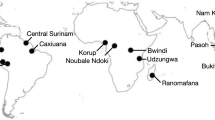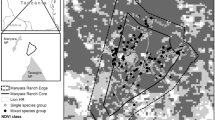Abstract
Predation is an ecologically important process, and intra-guild interactions may substantially influence the ecological effects of predator species. Despite a rapid expansion in the use of mathematical graph theory to describe trophic relations, network approaches have rarely been used to study interactions within predator assemblages. Assemblages of diurnal raptors are subject to substantial intra- and interspecific competition. Here we used the novel approach of applying analyzes based on network topology to species-specific data on the stable isotopes 13C and 15N in feathers to evaluate patterns of relative resource utilization within a guild of diurnal raptors in northern Sweden. Our guild consisted of the golden eagle (Aquila chrysaetos), the gyrfalcon (Falco rusticolus), the peregrine falcon (Falco peregrinus) and the rough-legged buzzard (Buteo lagopus). We found a modular trophic interaction structure within the guild, but the interactions were less nested than expected by chance. These results suggest low redundancy and hence a strong ecological importance of individual species. Our data also suggested that species were less connected through intra-guild interactions than expected by chance. We interpret our results as a convergence on specific isotope niches, and that body size and different hunting behaviour may mediate competition within these niches. We finally highlight that generalist predators could be ecologically important by linking specialist predator species with disparate dietary niches.


Similar content being viewed by others
References
Abrams P (1983) Arguments in favour of higher order interactions. Am Nat 121:887–891
Adams LG, Farley SD, Stricker CA, Demma DJ, Roffler GH, Miller DC, Rye RO (2010) Are inland wolf–ungulate systems influenced by marine subsidies of Pacific salmon? Ecol Appl 20:251–262
Anderson M, Erlinge S (1977) Influence of predation on rodent populations. Oikos 29:591–597
Bascompte J, Jordano P, Melian CJ, Olesen JM (2003) The nested assembly of plant-animal mutualistic networks. Proc Nat Acad USA 100:9383–9387
Brown WL, Wilson EO (1956) Character displacement. Syst Zool 5:49–64
Butts C (2008) Network: a package for managing relational data in R. J Stat Softw 24:2
Carvalheiro LG, Barbosa ERM, Memmott J (2008) Pollinator networks, alien species and the conservation of rare plants: Trinia glauca as a case study. J Appl Ecol 45:1419–1427
Catry I, Catry T, Alho M, Franco AMA, Moreira F (2016) Sexual and parent-offspring dietary segregation in a colonial raptor as revealed by stable isotopes. J Zool 299:58–67
Chisholm BS, Nelson DE, Schwartcz HP (1982) Stable carbon isotope ratios as a measure of marine versus terrestrial protein in ancient diets. Science 216:1131–1132
Clark WS (1999) A field guide to the raptors of Europe, the Middle East, and North Africa. Oxford University Press, Oxford
Dalerum F (2013) Phylogenetic and functional diversity in large carnivore assemblages. Proc R Soc Lond B Biol Sci 280:20130049
Dalerum F, Angerbjörn A (2005) Resolving temporal variation in vertebrate diets using naturally occurring stable isotopes. Oecologia 144:647–658
Dalerum F, Cameron EZ, Kunkel KE, Somers MJ (2012) Interactive effects of species richness and species traits on functional diversity and redundancy. Theor Ecol 5:129–139
Danon L, Guilera AD, Duch J, Arenas A (2005) Comparing community structure identification. J Stat Mech Theor Exp 9:P09008
Dormann CF, Strauss R (2014) A method for detecting modules in quantitative bipartite networks. Methods Ecol Evol 5:90–98
Dormann CF, Gruber B, Fruend J (2008) Introducing the bipartite package: analysing ecological networks. R news 8:8–11
Dunne J, Williams RJ, Martinez ND (2002) Network structure and biodiversity loss in food webs: robustness increases with connectance. Ecol Lett 5:558–567
Edelstam C (1984) Patterns of moult in large birds of prey. Act Zool Fenn 21:271–276
Ehrich D, Tarroux A, Stien J, Lecomte N, Killengreen S, Berteaux D, Yoccoz NG (2011) Stable isotope analysis: modelling lipid normalization for muscle and eggs from arctic mammals and birds. Methods Ecol Evol 2:66–76
Elton CS (1927) Animal ecology. Sidgwick and Jackson, London
Estrada E (2007) Characterization of topological keystone species local, global, and ‘meso-sale’ centralities in food webs. Ecol Complex 4:48–57
Fox AD, Hobson KA, Kahlert J (2009) Isotopic evidence for endogenous protein contributions to greylag goose Anser anser flight feathers. J Avian Biol 40(108):112
Freeman LC (1979) Centrality in social networks: conceptual clarification. Soc Netw 1:215–239
Galeano J, Pastor JM, Iriondo JM (2009) Weighted-interaction nestedness estimator (WINE): a new estimator to calculate over frequency matrices. Env Mod Software 24:1342–1346
Hellström P, Nyström J, Angerbjörn A (2014) Functional responses of the rough-legged buzzard in a multi-prey system. Oecologia 174:1241–1254
Holling CS (1973) Resilience and stability of ecological systems. Ann Rev Ecol Syst 4:1–23
Hothorn T, Hornik M, van der Wiel MA (2008) Implementing a class of permutation tests: the coin package. J Stat Softw 28:1–23
Jaksić FM, Braker HE (1983) Food-niche relationships and guild structure of diurnal birds of prey: competition versus opportunism. Can J Zool 61:2230–2241
Jollie M (1947) Plumage changes in the golden eagle. Auk 64:549–576
Jordán F (2009) Keystone species and food webs. Philos Trans R Soc Lond B Biol Sci 364:1733–1741
Jordán F, Wei-chung L, Davis AJ (2006) Topological keystone species: measures of topological importance in food webs. Oikos 112:535–546
Lindström E (1994) Large prey for small cubs-on crucial resources of a boreal red fox population. Ecography 17:17–22
Manly BFJ (1997) Randomization, bootstrap, and Monte Carlo methods in biology, 2nd edn. Chapman and Hall, London
Martínez del Rio C, Wolf N, Carleton SA, Gannes LZ (2009) Isotopic ecology ten years after a call for more laboratory experiments. Biol Rev 84:91–111
Martín-González AM, Dalsgaard B, Olesen JM (2010) Centrality measures and the importance of generalist species in pollination networks. Ecol Complex 7:36–43
May RM (1973) Stability and complexity in model ecosystems. Princeton University Press, Princeton
Mearns RJ (1983) The diet of the Peregrine Falco peregrinus in south Scotland during the breeding season. Bird Study 30:81–90
Miranda M, Parrini F, Dalerum F (2013) A categorization of network approaches to analyse trophic relationships. Methods Ecol Evol 4:897–905
Miranda M, Dalerum F, Parrini F (2014) Interaction patterns within a multi-herbivore assemblage derived from stable isotopes. Ecol Complex 20:51–60
Newman MEJ (2001) Scientific collaboration networks. II. Shortest paths, weighted networks, and centrality. Phys Rev E 64:016132
Newman MEJ (2006) Modularity and community structure in networks. Proc Nat Acad Sci USA 113:8577–8582
Nyström J, Ekenstedt J, Engström J, Angerbjörn A (2005) Gyr falcons, ptarmigan and microtine rodents in northern Sweden. Ibis 147:587–597
Nyström J, Ekenstedt J, Angerbjörn A, Thulin L, Hellström P, Dalen L (2006) Golden eagles on the Swedish mountain tundra-diet and breeding success in relation to prey fluctuations. Ornis Fenni 83:145–152
Opsahl T (2009) Projecting two-mode networks onto weighted one-mode networks. http://toreopsahl.com/2009/05/01/projecting-two-mode-networks-onto-weighted-one-mode-networks
Padrón B, Nogales M, Traveset A (2011) Alternative approaches of transforming bimodal into unimodal mutualistic networks. The usefulness of preserving weighted information. Basic Appl Ecol 12:713–721
Peterson BJ, Fry B (1987) Stable isotopes in ecosystem studies. Ann Rev Ecol Syst 18:293–320
Prado PI, Lewinsohn TM (2004) Compartments in insect–plant associations and their consequences for community structure. J Anim Ecol 73:1168–1178
Proulx SR, Promislow DEL, Phillips PC (2005) Network thinking in ecology and evolution. Trends Ecol Evol 20:345–353
Reitan M (2013) Assessing the diet of the golden eagle (Aquila chrysaetos) and the biomagnification of metals by use of stable isotope analyses and ICP-MS. MSc thesis, Department of Biology, Norwegian University of Science and Technology, Trondheim, Norway
Rosenfield RN, Schneider JW, Papp JM, Seegar WS (1995) Prey of peregrine falcons breeding in west Greenland. Condor 3:763–770
Schoener TW (1974) Resource partitioning in ecological communities. Science 185:27–39
Sergio F, Newton I, Marchesi L, Pedrini P (2006) Ecologically justified charisma: preservation of top predators delivers biodiversity conservation. J Anim Ecol 43:1049–1055
Sih A, Englund G, Wooster D (1998) Emergent impacts on multiple predators on prey. Trends Ecol Evol 13:350–355
Still CJ, Berry JA (2003) Global distribution of C3 and C4 vegetation: carbon cycle implications. Glob Biogeochem Cycl 17:1006
Stouffer DB, Bascompte J (2011) Compartmentalization increases food-web persistence. Proc Natl Acad USA 108:3648–3652
Sugihara G (1984) Graph theory, homology and food webs. Am Math Soc 30:83–101
Szymanski ML, Afton AD, Hobson KA (2010) Use of stable isotope methodology to determine natal origins of mallards at a fine scale within the upper Midwest. J Wildl Manage 71:1317–1324
Taylor RJ (1984) Predation. Springer, New York
Terborgh J, Estes J, Paquet P, Ralls K, Boyd-Heger D, Miller BJ, Noww RF (1999) The role of top carnivores in regulating terrestrial ecosystems. In: Soule ME, Terborgh J (eds) Continental conservation: Scientific foundations for regional reserve networks. Island Press, Washington DC, pp 39–64
Thébault E, Fontaine C (2010) Stability of ecological communities and the architecture of mutualistic and trophic networks. Science 329:853–856
Tjernberg M (1981) Diet of the golden eagle Aquila chrysaetos during the breeding season in Sweden. Holarct Ecol 4:12–19
Urton EJM, Hobson KA (2005) Intrapopulation variation in grey wolf isotope (δ15N and δ13C) profiles: implication for the ecology of individuals. Oecologia 145:317–326
Weiser EL, Powell AN (2011) Evaluating gull diets: a comparison of conventional methods and stable isotope analysis. J Field Ornithol 82:297–310
Woodroffe R, Ginsberg JR (2005) King of the beast: evidence for guild redundancy among large mammalian carnivores. In: Ray J, Redford KH, Steneck R, Berger J (eds) Large carnivores and the conservation of biodiversity. Island Press, Washington DC, pp 154–176
Author contribution statement
FD and AA conceived the study, PH, JN and JE conducted the research, FD and MM analyzed the data, FD, MM, AA and PH wrote the manuscript.
Author information
Authors and Affiliations
Corresponding author
Additional information
Communicated by Seth Newsome.
Rights and permissions
About this article
Cite this article
Dalerum, F., Hellström, P., Miranda, M. et al. Network topology of stable isotope interactions in a sub-arctic raptor guild. Oecologia 182, 511–518 (2016). https://doi.org/10.1007/s00442-016-3658-6
Received:
Accepted:
Published:
Issue Date:
DOI: https://doi.org/10.1007/s00442-016-3658-6




